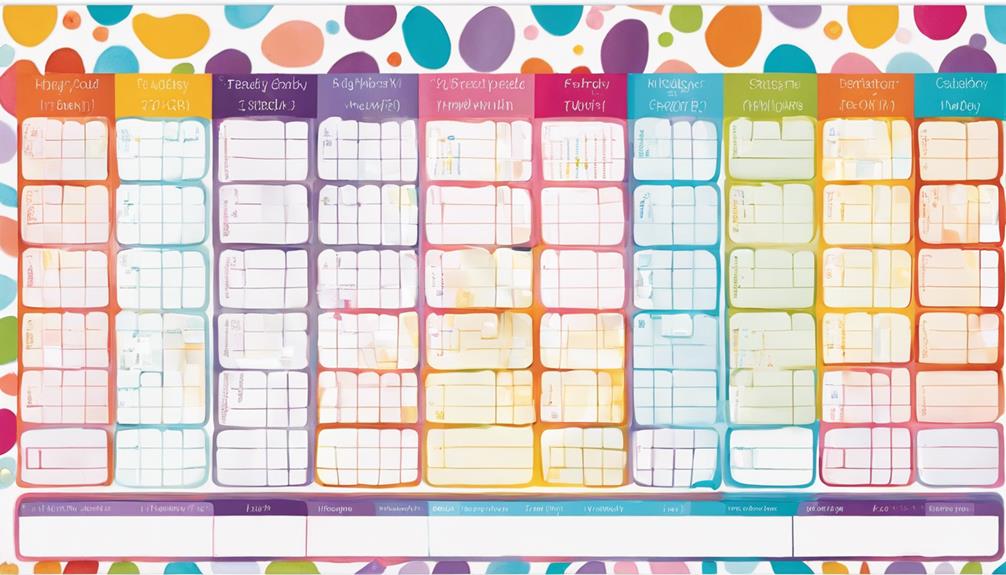As parents, creating a feeding schedule for a 6-month-old who is formula-fed is like following a delicate recipe – the key is to find the perfect balance of timing, quantities, and ingredients to adequately nourish our little ones. Just when we think we’ve got it all figured out, our babies throw us a curveball, leaving us to wonder, “What’s next?”
In our detailed guide, we unravel the intricacies of feeding routines for 6-month-olds, offering insights into optimizing nutrition, adapting to cues, and fostering healthy eating habits.
So, let's navigate this journey together, ensuring our babies thrive every step of the way.
Key Takeaways
- Formula-fed 6-month-olds need 24-32 oz daily, divided into 4-6 feedings.
- Pay attention to hunger cues for appropriate feeding amounts and frequency.
- Introduce solid foods gradually alongside formula to provide balanced nutrition.
- Monitoring growth, weight gain, and well-being is essential for establishing a feeding routine.
Feeding Guidelines for 6-Month-Olds
When feeding 6-month-olds formula, it's important to follow recommended guidelines to guarantee their nutritional needs are met effectively. At this age, a formula-fed baby typically consumes around 2½ ounces of formula per pound of body weight daily. This translates to about 24-32 ounces of formula spread over 4-6 feedings per day.
It's essential to pay attention to hunger cues to determine the appropriate amount of formula and feeding frequency for your baby. Signs of fullness, such as becoming fidgety or easily distracted during feedings, indicate that your little one may have had enough.
Establishing a Routine for Formula Feeding

To confirm your 6-month-old's nutritional needs are consistently met, establishing a routine for formula feeding is key to promoting their overall health and development. A formula-fed baby of this age typically requires 24-32 oz of formula per day, distributed across 4-6 feedings.
It's important to be flexible with feeding times and amounts, responding to your baby's hunger cues. Introducing solid foods alongside formula feeds can help provide balanced nutrition as your baby grows.
Monitoring their growth, weight gain, and overall well-being is critical in adjusting the formula feeding schedule to meet their evolving needs. By creating a structured routine for formula feeding, you can make sure that your little one receives the necessary nutrients for the best development and health.
Balancing Formula Feedings for Infants
Establishing a well-balanced formula feeding routine is important for the best growth and development of infants at the age of 6 months. As a parent, it's essential to monitor your 6-month-old formula-fed infant's formula intake, aiming for around 2½ ounces per pound of body weight daily. To help you navigate this balancing act effectively, we've compiled a guide below:
| Key Points | Details | Action |
|---|---|---|
| Formula Intake | Aim for 2½ ounces per pound of body weight daily, not exceeding 32 ounces in a 24-hour period. | Monitor and adjust as needed. |
| Signs of Fullness | Watch for cues like becoming fidgety or easily distracted during feedings. | Respect your baby's cues for feeding. |
| Pediatrician Consultation | If your baby consistently wants more or less formula, consult with a pediatrician for guidance. | Make sure appropriate feeding adjustments are made. |
Transitioning to Solids at 6 Months

Introducing a variety of iron-rich foods and textures gradually alongside formula feedings is crucial for supporting your 6-month-old's growth and development. At this stage, shifting to solids should be a gentle process. Begin with iron-fortified cereals, pureed meats, and vegetables to make certain your baby gets essential nutrients.
Encourage self-feeding by offering soft fruits, cooked vegetables, and cereals for developing independence and fine motor skills. Aim for 1-2 meals of solids per day, spaced out from formula feeds to allow for proper digestion and response to hunger cues.
Consulting with a pediatrician or dietitian can provide personalized guidance on this journey, helping you strike the right balance between formula and solid foods for your 6-month-old. Their expertise can ensure a smooth switch and address any concerns you may have, making the experience both beneficial and enjoyable for you and your baby.
Ensuring Nutritional Needs for 6-Month-Olds
Ensuring the nutritional needs of your 6-month-old is vital for their growth and development. A formula-fed 6-month-old typically requires about 2½ ounces of formula per pound of body weight daily, not exceeding 32 ounces in a 24-hour period.
It's important to watch for signs of fullness like becoming fidgety or easily distracted to prevent overfeeding. In the early days, newborns usually start with 1-2 ounces of formula every 2-3 hours, adjusting as they grow and their appetite increases.
Paying attention to your baby's cues is key in determining their milk intake. If your baby consistently seems to want more or less formula, consulting with a pediatrician can provide valuable guidance.
Frequently Asked Questions
What Is the Formula Schedule for a 6 Month Old?
We guarantee our 6-month-old's formula schedule includes 4-5 feedings daily, 6-8 ounces per feeding. Generally, they consume 24-32 ounces daily, with feedings spaced every 3-4 hours. Adjustments are made based on hunger cues for a consistent routine.
What Is the Bottle Fed Routine for a 6 Month Old?
We've found that a 6-month-old's bottle feeding routine usually involves 4-5 feedings spaced throughout the day with 24-32 ounces of formula. Introduce solids gradually, offer water in a sippy cup, and adjust amounts based on hunger cues for healthy feeding habits.
How Much Formula Should a 6 Month Old Be Eating?
We observe our 6-month-old's cues to determine their formula intake, usually around 2½ oz per pound of body weight daily. Signs of fullness like fidgetiness guide us to respect their hunger cues. It's essential not to surpass 32 oz in 24 hours.
What Is the Food Routine for a 6 Month Old?
We focus on a 6-month-old's feeding routine, incorporating 4-6 breast milk or formula feeds totaling 22-28 oz daily. Introducing 1-2 tbsp of purees alongside milk, monitoring hunger cues, and creating a cozy feeding atmosphere are essential for a balanced routine.
Conclusion
As we navigate the intricate dance of feeding our 6-month-old babies, let's remember that we're the conductors of a symphony of nourishment, balance, and growth.
By tuning in to their cues, harmonizing formula with solids, and orchestrating their nutritional needs, we're crafting a masterpiece of health and well-being.
Trust in your instincts, seek guidance when needed, and watch as your little one flourishes under your loving care.
The journey of feeding is a beautiful melody, let's savor every note.










